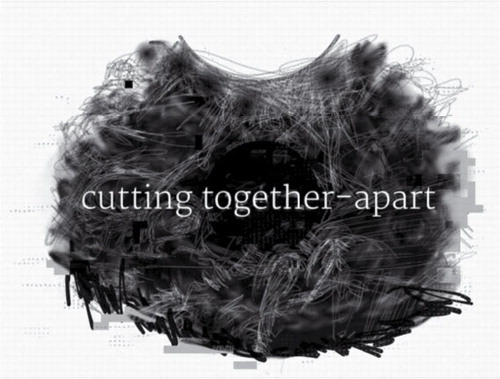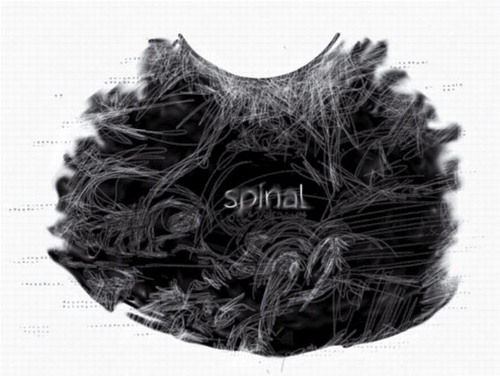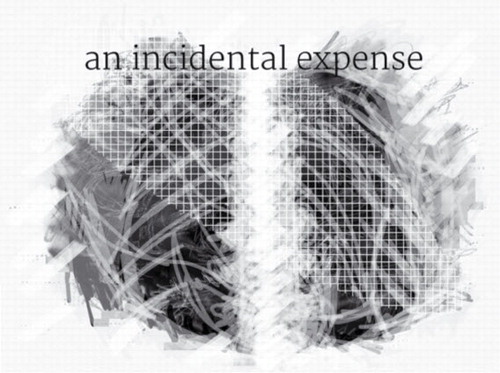This ‘entangled beginning’ (Barad Citation2007) is at the end of a long journey. Here are my pregnancies unravelled in a few pages. I have been years here, situated somewhere between the front and the backmatter. This time has seemed both as long as finding and counting lost cells, and as short as placing my right thumb on the top edge of the page at the top right corner, sliding the fingers of my right hand down the back of the page and gently pushing the page to the left. In this time I have crossed disciplinary thresholds, and cultural lines, as well as carrying my aberrant cells over geographical borders. As a performer-researcher, I have held moments of miscarriage both here and there. The cogno-innovative knowledges that follow serve as 'an endless cycle of exploration, exploitation and explanation' (Gummerum and Denham Citation2014: 586) both cleaving apart and together new understandings of the corporeal.
The miscarriage, an accidental detachment, is a stochastic process. The weight of the additional knowledges that the multiple miscarriage offers the body are further porous and indefinite: a curious cogitatum. Karen Barad in Meeting the Universe Halfway explores diffractive practices by dialogically engaging across texts so that they are read ‘through one another’ (2007: 30) to illuminate unexpected outcomes. In the experience of multiple miscarriages, the possibilities of becoming visible, of an emergent ‘intra-action’ (Barad Citation2007), fall beyond the finngers. A vector of disease brings unease, and yet through perseverance ‘[t]hrough imagined touch we may experience a tactile intimacy with things that are removed from us. This possibility relies on experience, memory and expectation’ (Johnson Citation1997: 297).
To explore the diffracted-self that occurs after multiple miscarriages means to hold close what remains, the stranger of my own body: the body who wears a lack of purpose, who cannot be ‘located in the present’ (Ahmed Citation2000: 8). It is to give value to the changes my body has accumulated, responding as it has each time, accordingly. I notice that I hold some postpartum narratives still in my flesh, embedded in shifted landmarks, and a quiet softness. The non-generative post-partum body is often quiet.
If as Franco La Cecla writes ‘[t]he fear of getting lost is sometimes stronger than the act itself, because it means to be adrift' (2000: 33), then how might I get lost within the site of my own body, to rediscover its materiality?
In my internal ‘dark ecology’ (Morton Citation2016), where my pouch of Douglas measures at the deepest point of the peritoneal cavity, the echo extends from the curvature of the stomach and doubles back, passing in front of the small intestines. I send a tuneless hum into this space. As I attempt to understand my un-relations, my kin, I think I understand Haraway when she suggests, ‘[m]aking kin is perhaps the hardest and most urgent part … Kin-making is making persons, not necessarily as individuals or as humans’ (2015: 161).
The experience of un-pregnancy is to be both pocketful and out of pocket. It is the grainy ‘dust’ in the seam of a pocket which speaks to the hands once held there. Every 28 days I buy other peoples’ clothes to feel the grit of biscuits eaten long ago; the rooms visited; the small quotidian rituals of placing one’s hands. Trembling at the care taken to hold their crumbling cells under my fingernails, I take these motes on journeys.
Pockets, with their bag-like form, are expert at holding nothing and something, and nothing and something. They are a container for familiar domestic thingliness. They are open-ended. They are accessible mouths, both silent and noisy. They are artefacts of utility. They are agents of touch. They fold intimacy.
The pocket is also a smile.
References:
- Ahmed, Sara (2000) Strange Encounters: Embodied others in post-coloniality, London: Routledge.
- Barad, Karen (2007) Meeting the Universe Halfway: Quantum physics and the entanglement of matter and meaning, Durham and London: Duke University Press.
- Gummerum, Michaela and Susan Denham (2014) ‘Cognitive Innovation: From cell to society’, editorial, Europe’s Journal of Psychology 10 (4), January: 586-88. doi: 10.5964/ejop.v10i4.879
- Haraway, Donna (2015) ‘Anthropocene, Capitalocene, Plantationocene, Chthulucene’, Environmental Humanities 6 (1): 159–65. doi: 10.1215/22011919-3615934
- Johnson, Pamela (1997) ‘Out of Touch: The meaning of making in the digital age’, in Tanya Harrod (ed.) Obscure Objects of Desire, London: Crafts Council, pp. 292-99.
- La Cecla, Franco (2000) ‘Getting Lost and The Localized Mind’, in Architecturally Speaking: Practices of art, architecture and the everyday, edited by Alan Read, London. Routledge: pp. 31-48.
- Morton, Timothy (2016) Dark Ecology, New York: Columbia University Press.






